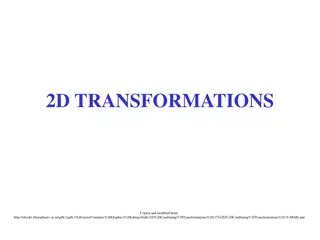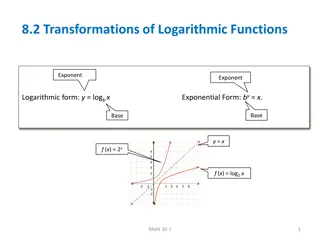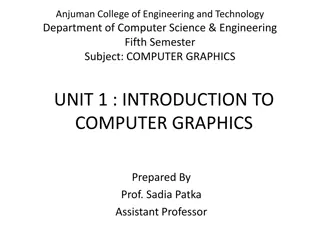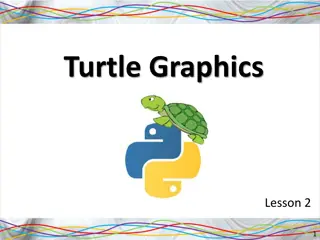Understanding 3D Transformations in Computer Graphics
Transformation plays a crucial role in computer graphics, enabling movement and manipulation of objects in a Cartesian plane. This comprehensive guide covers types of transformations, reasons for using them, and details on 3D translation, rotation, scaling, reflection, and shearing. Explore the significance of transformations in modeling and viewing objects in a 3D space, along with the matrix representations for translation and rotation.
Download Presentation

Please find below an Image/Link to download the presentation.
The content on the website is provided AS IS for your information and personal use only. It may not be sold, licensed, or shared on other websites without obtaining consent from the author. Download presentation by click this link. If you encounter any issues during the download, it is possible that the publisher has removed the file from their server.
E N D
Presentation Transcript
CONTENTS Transformation Types of transformation Why we use transformation 3D Transformation 3D Translation 3D Rotation 3D Scaling 3D Reflection 3D Shearing
TRANSFORMATION Transformations are a fundamental part of the computer graphics. Transformations are the movement of the object in Cartesian plane .
TYPES OF TRANSFORMATION There are two types of transformation in computer graphics. 1) 2D transformation 2) 3D transformation Types of 2D and 3D transformation 1) Translation 2) Rotation 3) Scaling 4) Shearing 5) Mirror reflection
WHY WE USE TRANSFORMATION Transformation are used to position objects , to shape object , to change viewing positions , and even how something is viewed. In simple words transformation is used for 1) Modeling 2) viewing
3D TRANSFORMATION When the transformation takes place on a 3D plane, it is called 3D transformation. Generalize from 2D by including z coordinate Straight forward for translation and scale, rotation more difficult a b c t Homogeneous coordinates: 4 components x d e f t y Transformation matrices: 4 4 elements g h i t z 0 0 0 1
3D TRANSLATION Moving of object is called translation. In 3 dimensional homogeneous coordinate representation , a point is transformed from position P = ( x, y , z) to P =(x ,y , z ) This can be written as:- Using P = T . P 1 0 0 x t x x 0 1 0 y t y y = 0 0 1 z t z z 1 0 0 0 1 1
3D TRANSLATION The matrix representation is equivalent to the three equation. x =x+ tx , y =y+ ty , z =z+ tz Where parameter tx , ty , tz are specifying translation distance for the coordinate direction x , y , z are assigned any real value.
3D ROTATION Where an object is to be rotated about an axis that is parallel to one of the coordinate axis, we can obtain the desired rotation with the following transformation sequence. Coordinate axis rotation Z- axis Rotation Y-axis Rotation X-axis Rotation
X-AXIS ROTATION The equation for X-axis rotation x = x y = y cos z sin z = y sin + z cos ' 1 0 0 0 x x ' cos 0 cos sin 0 y y = ' 0 sin 0 z z 1 0 0 0 1 1
Y-AXIS ROTATION The equation for Y-axis rotaion x = x cos + z sin y = y z = z cos - x sin ' cos 0 sin 0 x x ' 0 1 0 0 y y = ' sin 0 cos 0 z z 1 0 0 0 1 1
Z-AXIS ROTATION The equation for Z-axis rotation x = x cos y sin y = x sin + y cos z = z cos ' cos sin 0 0 x x ' sin 0 0 y y = ' 0 0 1 0 z z 1 0 0 0 1 1
3D SCALING Changes the size of the object and repositions the object relative to the coordinate origin. 0 s 0 0 x s x x 0 0 s 0 y y y = 0 0 0 z z z 1 0 0 0 1 1
3D SCALING The equations for scaling x = x . sx Ssx,sy,szy = y . sy z = z . sz
3D REFLECTION Reflection in computer graphics is used to emulate reflective objects like mirrors and shiny surfaces Reflection may be an x-axis y-axis , z-axis. and also in the planes xy-plane,yz-plane , and zx-plane. Reflection relative to a given Axis are equivalent to 180 Degree rotations
3D REFLECTION Reflection about x-axis:- x =x y =-y z =-z 1 0 0 0 0 -1 0 0 0 0 -1 0 0 0 0 1 Reflection about y-axis:- y =y x =-x z =-z
3D REFLECTION The matrix for reflection about y-axis:- -1 0 0 0 0 1 0 0 0 0 -1 0 0 0 0 1 Reflection about z-axis:- x =-x y =-y z =z -1 0 0 0 0 -1 0 0 0 0 1 0 0 0 0 1
3D SHEARING Modify object shapes Useful for perspective projections to produce images look natural When an object is viewed from different directions and at different distances, the appearance of the object will be different. Such view is called perspective view. Perspective projections mimic what the human eyes see.
3D SHEARING We can denote shearing with SHx, SHy, and SHz. These SHx, SHy, SHz are called Shearing factor.
3D SHEARING We can perform shearing on the object by following three ways- 1. Shearing along the x-axis: In this, we can store the x coordinate and only change the y and z coordinate. We can represent shearing along x-axis by the following equation- x1= x0 y1= y0+ SHy. x0 z1= z0+ SHz. X0 3D Shearing Matrix: In Matrix form, the above shearing equations may be represented as-
3D SHEARING 2. Shearing along the y-axis: In this, we can store the y coordinate and only change the x and z coordinate. We can represent shearing along with y-axis by the following equation- x1= x0+ SHx. y0 y1= y0 z1= z0+ SHz. Y0 3D Shearing Matrix: In Matrix form, the above shearing equations may be represented as-
3D SHEARING 3. Shearing along with z-axis: In this, we can store the z coordinate and only change the x and y coordinate. We can represent shearing along with z-axis by the following equation- x1= x0+ SHx. z0 y1= y0+ SHy. Z0 z1= z0 3D Shearing Matrix: In Matrix form, the above shearing equations may be represented as-























